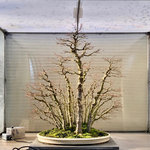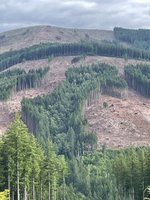Maybe I woke up on the wrong side of the bed this morning, but there are some bonsai terms that irritate me as they give off the wrong impressions. Some examples:
1) Training one's bonsai - bonsai are not trainable. They are not sentient and have no brains. A dog may naturally poo where he wants, but can be trained to poo on a pad. You can never change the nature of a tree. It will always poo where it wants. We can never obtain even a Pavlovian response from a tree. Trees will always want to grow big and tall. We are DEVELOPING our trees to do something else. But make no mistake, no one has ever trained a tree out of its nature.
2) Fertilizing as feeding one's tree - fertilizer is not tree food. The only thing a tree eats are the sugars produced from photosynthesis. Fertilizers is more akin to a multi-vitamin for humans - essential minerals, but not the protein and fat (calories) that humans live on. Trees get fat by "eating" a lot of sugars produced from lots of foliage, not by fertilizing more.
3) Indoor bonsai - ?como? what exactly is an indoor tree? Almost like an out-of-water fish. Fish live ok out of water I guess if you attach something to it that pumps water through its gills. Which is to say there are no out of water fish really. Same with trees. If we put the tree under lights with fans and watch the humidity, we basically "attached something to it that pumps water through its gills." Which is to say there really are no indoor trees.
4) Forest planting - more often than not, this is just not the case. Group plantings, maybe, but not forests.
5) pre-bonsai - a pretty meaningless term. Basically, anything other than a finished tree.
6) Bonsai rules - there are no bonsai rules. You don't get in trouble for breaking any such rules. You are free to do what you want. There is, however, bonsai theory which provides certain guidelines for how to develop a realistic looking tree.
7) starter material - another meaningless term, as we all have different ideas of what we want to begin with.
1) Training one's bonsai - bonsai are not trainable. They are not sentient and have no brains. A dog may naturally poo where he wants, but can be trained to poo on a pad. You can never change the nature of a tree. It will always poo where it wants. We can never obtain even a Pavlovian response from a tree. Trees will always want to grow big and tall. We are DEVELOPING our trees to do something else. But make no mistake, no one has ever trained a tree out of its nature.
2) Fertilizing as feeding one's tree - fertilizer is not tree food. The only thing a tree eats are the sugars produced from photosynthesis. Fertilizers is more akin to a multi-vitamin for humans - essential minerals, but not the protein and fat (calories) that humans live on. Trees get fat by "eating" a lot of sugars produced from lots of foliage, not by fertilizing more.
3) Indoor bonsai - ?como? what exactly is an indoor tree? Almost like an out-of-water fish. Fish live ok out of water I guess if you attach something to it that pumps water through its gills. Which is to say there are no out of water fish really. Same with trees. If we put the tree under lights with fans and watch the humidity, we basically "attached something to it that pumps water through its gills." Which is to say there really are no indoor trees.
4) Forest planting - more often than not, this is just not the case. Group plantings, maybe, but not forests.
5) pre-bonsai - a pretty meaningless term. Basically, anything other than a finished tree.
6) Bonsai rules - there are no bonsai rules. You don't get in trouble for breaking any such rules. You are free to do what you want. There is, however, bonsai theory which provides certain guidelines for how to develop a realistic looking tree.
7) starter material - another meaningless term, as we all have different ideas of what we want to begin with.








